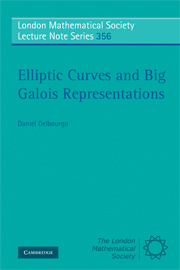Book contents
- Frontmatter
- Contents
- Introduction
- List of Notations
- Chapter I Background
- Chapter II p-Adic L-functions and Zeta Element
- Chapter III Cyclotomic Deformations of Modular Symbols
- Chapter IV A User's Guide to Hida Theory
- Chapter V Crystalline Weight Deformations
- Chapter VI Super Zeta-Elements
- Chapter VII Vertical and Half-Twisted Arithmetic
- Chapter VIII Diamond-Euler Characteristics: the Local Case
- Chapter IX Diamond-Euler Characteristics: the Global Case
- Chapter X Two-Variable Iwasawa Theory of Elliptic Curves
- Appendices
- Bibliography
- Index
Chapter IV - A User's Guide to Hida Theory
Published online by Cambridge University Press: 04 May 2010
- Frontmatter
- Contents
- Introduction
- List of Notations
- Chapter I Background
- Chapter II p-Adic L-functions and Zeta Element
- Chapter III Cyclotomic Deformations of Modular Symbols
- Chapter IV A User's Guide to Hida Theory
- Chapter V Crystalline Weight Deformations
- Chapter VI Super Zeta-Elements
- Chapter VII Vertical and Half-Twisted Arithmetic
- Chapter VIII Diamond-Euler Characteristics: the Local Case
- Chapter IX Diamond-Euler Characteristics: the Global Case
- Chapter X Two-Variable Iwasawa Theory of Elliptic Curves
- Appendices
- Bibliography
- Index
Summary
The philosophy behind deformation theory is straightforward. One starts off with a mathematical problem about an object say, which may be too hard to solve. The idea is to view this object as a single member of a family of objects {fk} parametrised by the variable k. With a bit of luck, the variation in k should be analytic (in a suitable sense). One then translates the original problem regarding into an even bigger question concerning the whole family {fk}.
At this point the reader might well protest, surely this has made life harder? The surprising answer – and the real magic of deformation theory – is that by deforming the problem, we have actually made life easier. The underlying reason is that for the analytic family {fk} we have tools and techniques at our disposal, which are unavailable for each individual family member. If one can then solve the bigger problem, the delicate part is to translate back in terms of the original element. This last step requires what is known as a Control Theory.
The previous chapter saw us develop a cyclotomic control theory for M-symbols. Over the next fifteen pages or so, we give a short (and by no means complete) background on the control theory in the weight direction. In the ordinary case, this theory was primarily developed by Hida in a long series of articles [Hi1,Hi2,Hi3].
- Type
- Chapter
- Information
- Elliptic Curves and Big Galois Representations , pp. 70 - 85Publisher: Cambridge University PressPrint publication year: 2008



